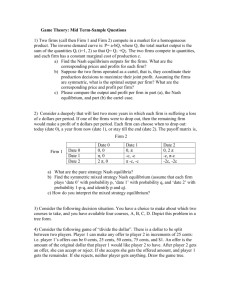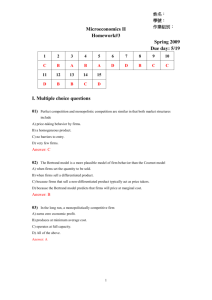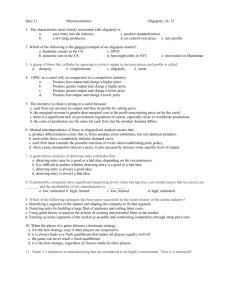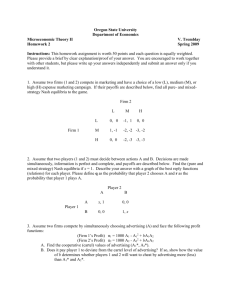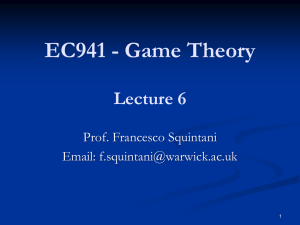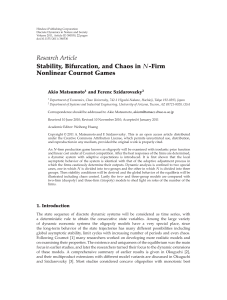Managerial Economics - 2016 - Segment 2.3
advertisement
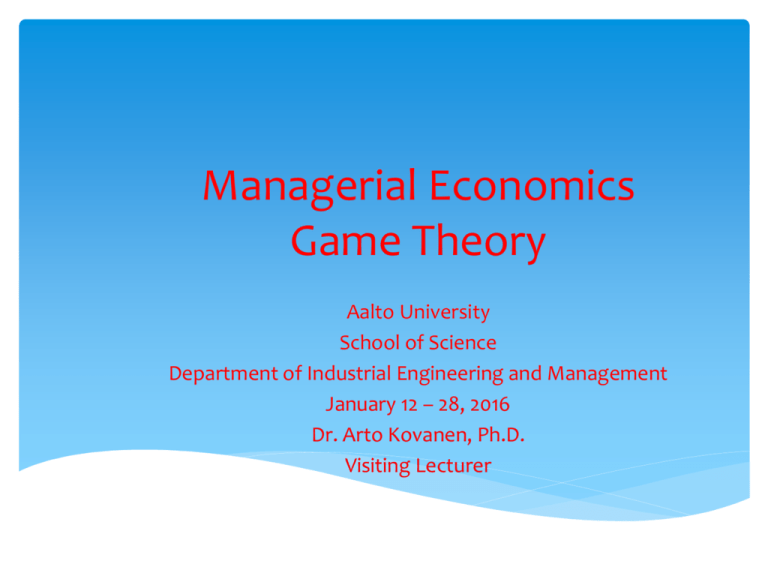
Managerial Economics Game Theory Aalto University School of Science Department of Industrial Engineering and Management January 12 – 28, 2016 Dr. Arto Kovanen, Ph.D. Visiting Lecturer General considerations We have considered three models of industrial structures, monopoly, pure competition, and monopolistic competition (everything in between) In the last two cases the action of each firm depends on the actions of other firms We can assume that the actions of other are given to a firm if each firm is relatively small When there are few firms, each firm constitute a rather large part of the market; this is called oligopoly General considerations When there are only two firms, the structure is called duopoly With few firms in the market, strategic interaction between the firms become an important part of the outcome In what follows, we discuss alternative strategic interactions between firms and how they impact production and pricing decisions To limit the power of oligopolies, there are public policy issues which we discuss later Game theory Game theory analyzes strategic interaction Payoff matrix describes the strategic interaction Assume two individuals Person A will write one of two words on a piece of paper, “top” or “bottom” Simultaneously, person B will independently write words “left” or “right” on a piece of paper Suppose that the payoff matrix of the game will be Person B Left Right Person A Top 1,2 0,1 Bottom 2,1 1,0 Game theory What will be the outcome of the game? For person A it is always better to say “bottom” For person B it is always better to say “left” In this game, there is a dominant strategy: bottom/left This will be also the equilibrium strategy However, dominant strategies do not always happen Suppose there is no dominant strategy for the game Then the optimal choice depends on what the player thinks the other person is going to do Game theory Person A Top Bottom Person B Left Right 2,1 0,0 0,0 1,2 Nash equilibrium: a pair of strategies where A’s choice is optimal given B’s choice and B’s choice is optimal given A’s choice Neither person know what the other is going to do, but can have expectations about it In the above table, the combination of “top”/”left” is a Nash equilibrium (this is optimal for both) Game theory The Nash has some problems: First, there may be more than one equilibrium (choice “bottom”/”right” is a feasible) Some games have no Nash equilibrium See also: Mixed strategies: pure and mixed Prisoner’s dilemma Repeated games Sequential games Game theory Prisoner’s dilemma – payoff matrix (years in prison) Prisoner B Confess Deny Prisoner A Confess -3, -3 0, -6 Deny -6, 0 -1, -1 What is the best outcome? If both deny, they would of course be best off! Is it credible? If one denies, the other one is better off by confessing Lack of coordination important for the outcome! Game theory Problem is how to coordinate the actions! This applies to a wide range of economic and political situations Arms control: if there is no way of making a binding agreement, both sides end up deploying missiles Cheating in a cartel: if you think the other side will stick to the agreed quota, it will pay off to produce more than your own quota Game theory Sequential games There are situations where one player gets to move first and then the second player responds (Stackelberg) A chooses A choose B chooses Left (1,9) B chooses Right (1,9) B chooses Left (0,0) B chooses Right (2,1) Top Bottom Game theory To analyze this game, work backwards If player A chooses “Top”, B’s choice does not matter for his payoff (1, 9) If player A chooses “Bottom”, it matters what B chooses But player A is better of choosing “Bottom” Practical example: monopoly fights to avoid entrance of a new firm in the market (“pre-emptive” action) Could also apply to a oligopoly where a dominant firm encourages entry by lowering the threshold price below cost for others (for instance, Saudi oil and US shale gas) Game theory – Cournot model This model is relevant for markets where two firms are competing, but also applies to markets with few firms (e.g., Coca-Cola and Pepsi) Firms produce homogeneous products There are many buyers Each firm determines its output based on the other’s action (estimated) Example. Let market demand be P = 400 – 2*(Q1+Q2) Each firm has MC = $ 40 and no fixed costs Game theory – Cournot model Profits of each firm are as follows: π1 = (400 – 2Q1 – 2Q2)Q1 – 40Q1 = 360Q1 – 2Q22 – 2Q1*Q2 (The second firm has a similar profit function) Solve for optimal output for firm 1: dπ1 = dQ1 = 0, which gives us Q1 = 90 – 0.5Q2 Note that firm 1 does not know the value of Q2 with certainty and therefore has to estimate it (e.g., based on total market demand forecast in which Q2 would be a residual) Game theory – Cournot (cont.) The equilibrium is found in the intersection of the firms’ optimal positions (which depend on the other firm’s reaction function) That is, solve for Q1 = 90 – 0.5Q2 Q2 = 90 – 0.5 Q1 Since firms are identical, the optimal Q1 = Q2 = 60 for both firms Given total production of 120, P = 400 – 2*120 = $ 160 Illustrate the strategic interaction between these firms in the market Game theory – Cournot (cont.) The game changes a bit if one of the firms is a “leader” while the other is a “follower” For the follower the optimal outcome is the same as above (i.e., follower is taking into account the leader’s possible action) The leader, on the other hand, does not account for the follower’s action when determining its output P(L) = 400 – 2*[Q(L) + (90 – 0.5*Q(L))] = 220 – Q(L) π(L) = (220 – Q(L))*Q(L) – 40*Q(L), which gives us Q(L) equal to 90 (which is higher than 60 above) Game theory – Cournot (cont.) The follower will then produce Q(F) = 45 and P = $ 130 Comparison to Cournot equilibrium, we observe that P is lower Q(L) is higher and Q(F) is lower Profits of the leader are higher and profits of the follower are lower Total industry profits lower because total output is higher and hence price has to come down in equilibrium Examples of market leaders: Is Apple a market leader in smart phone markets (not homogeneous products and what is means for pricing)? Homogeneous products: Banks and cuts in loan rates?


